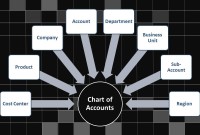- Home
- Business Processes
- Industry Knowledge
- Aerospace Industry
- Automotive Industry
- Banking Domain
- BFSI Industry
- Consumer/ FMCG Industry
- Chemicals Industry
- Engineering & Construction
- Energy Industry
- Education Domain
- Finance Domain
- Hospitality Domain
- Healthcare Industry
- Insurance Domain
- Retail Industry
- Travel and Tourism Domain
- Telecom Industry
- Leadership Skills
- eLearning
- Home
- Business Processes
- General Ledger (Record to Report)
- What are Management Entities?
What are Management Entities?
In this article we will discuss various types of "Management Entities". Various types of operational units, are created by management, to effectively run, manage and control their business. Different types of functional units, and divisional units, are widely used across industry.
In this article, we will discuss various types of "Management Entities".
Various types of operational units, are created by management, to effectively run, manage and control their business.
Different types of functional units, and divisional units, are widely used across industry.
What are some commonly used, "Management Entities"?
Various types of operational units, functional units and divisional units, that are widely used across industry are.
- Management Entity, or Business Units.
- Departments and Divisions.
- Business Functions.
- Cost centers.
- Profit Centers.
- Business Locations.
- Product Lines.
- Project Area.
Why Management Entities?
Internally, an organization can be structured in many different ways.
A large number of entities, can be created and tracked, depending on the management‘s objectives.
We have seen in our earlier article on Legal entities, that the legal entities are required, to be defined for external reporting, and compliance.
However, Management defines management entities, primarily for driving internal objectives.
They need these operational units, to efficiently manage their business, and effectively run it.
We know that big multinational organizations, operate in a matrix environment.
Management entities facilitate, division of responsibilities, and enables seamless flow of information, across the organization.
By defining required management entities, management can enable, tracking of various operations, financials, or profitability, for each of these entities.
These different views, can enable, granular tracking of business operations, by various dimensions, like, geographies, countries, locations, business segments, product lines, cost centres, functions, COE’s etc.
That's why, these entities are also, sometime referred to as "operating units".
Definition of Management Entity.
Actually, in real business parlance, A Management Entity, could mean anything, that the management wants.
It could be a business division, a specific type of unit, or department, or even a business function.
Some of the attributes, generally associated with management entities are.
Management of Funds; Management entities manage, on a discretionary basis, funds or portfolios, pursuant to a business mandate.
Used for financial reporting, and enables tracking of expenses, at a granular level.
These entities serve independently of legal entities.
Essentially, it is an autonomous, or a semi-autonomous, operating unit.
They are generally created to, meet strategic business objectives.
They help the management to better manage, their business activities.
They are created primarily, to promote business efficiency.
In our next articles, we will cover detailed discussions on, how companies use departments, functions, cost centres, locations, product lines etc., to create different management entities, and reporting dimensions.
Business Functions
An operating unit that represents a category or functional part of an organization that performs a specific task to support business activity, such as sales or marketing to support business development. Used to report on functional areas. A support function may have allocated budgets and may consist of a group of cost centers.
Organization Support Functions
Self-directed activity systems of an organization concerned with establishing and maintaining the organization as an entity. Each organization support function provides support to all functions, business, business support and other organization support functions. For example, corporate finance, IT functions, administration and knowledge management. An organization support function may have allocated budgets and may consist of a group of cost centers.
Cost centers
A cost center is part of an organization that does not produce direct profit and adds to the cost of running a company. Examples of cost centers include marketing & finance departments. It is an operating unit in which managers are accountable for budgeted and actual expenditures. Used for the management and operational control of business processes that may span legal entities.
Profit Centers
A profit center is a part of a corporation that directly adds to its profit, treated as a separate business and for which the profits or losses are calculated separately. This operating unit is held accountable for both revenues, and costs (expenses), and therefore, profits. Different profit centers are separated for accounting purposes so that the management can measure their relative efficiency and profit.
Business Locations/ Countries/ Geography/ Supplier & Customer Locations
Organizations operate from more than one location and may need to track where a particular financial transaction occurred. Some examples of need to track different locations could be transactions through sales offices, factories, subsidiaries etc. Organizations may even need to analyze the financial information based on the supplier’s or customer’s location may require a location segment dedicated to this. However this has very limited application in terms of usefulness. E.g. software companies cater to clients from all over the world & may like to make strategies based on which customer territory contributed how much to the revenue & hence a customer location is an important segment but for a manufacturing organization this will hold no relevance.
Product Lines/Service Lines
Some organizations deal in products which are low in volume but high in value. These organizations would like to analyze their costs & revenue for individual products. They also need to apportion indirect costs & revenues to these products/services so that the financials provide a full picture on product performance. On the other hand, a supermarket dealing in thousands of product might not have any interest in recording every transaction against the individual product or track financials at product level. Further each legal entity in the group may have its own set of released products that it wants to include in transaction documents.
Project Area
Certain organizations have their business models build around project activities. E.g. a property developer may like to have all its cost & revenue against individual projects. These organizations may have multiple projects running under same legal entity. There projects have their own budget & statutory requirements & hence their own trial balance.
Related Links
You May Also Like
-
Explore the concept of journal reversals and understand the business scenarios in which users may need to reverse the accounting entries that have been already entered into the system. Understand the common sources of errors resulting in the reversal of entries and learn how to correct them. Discuss the reversal of adjustment entries and the reversal functionalities in ERPs.
-
The purpose of the general ledger is to sort transaction information into meaningful categories and charts of accounts. The general ledger sorts information from the general journal and converts them into account balances and this process converts data into information, necessary to prepare financial statements. This article explains what a general ledger is and some of its major functionalities.
-
In some of the ERP tools, there are more than 12 accounting periods in a financial year. This article discusses the concept of accounting calendar and accounting periods. Learn why different companies have different accounting periods. Understand some of the commonly used periods across different organizations and the definition & use of an adjustment period.
-
There are two commonly used methods of accounting - Cash Basis and the Accruals Basis. Understand the difference between accruals and reversals. Recap the earlier discussion we had on accruals and reversals and see the comparison between these two different but related accounting concepts. Understand how the action of accruing results in reversals subsequently in the accounting cycle.
-
The general ledger is the central repository of all accounting information in an automated accounting world. Summarized data from various sub-ledgers are posted to GL that eventually helps in the creation of financial reports. Read more to understand the role and benefits of an effective general ledger system in automated accounting systems and ERPs.
-
GL - Review & Approve Journals
Review and Approval mechanisms ensure that the accounting transaction is reasonable, necessary, and comply with applicable policies. Understand why we need review and approval processes, what are they, and how they are performed in automated general ledger systems. Learn the benefits of having journal approval mechanisms in place.
-
In this article we will discuss various types of "Management Entities". Various types of operational units, are created by management, to effectively run, manage and control their business. Different types of functional units, and divisional units, are widely used across industry.
-
A Company (also called corporation) may be understood as an association of persons in which money is contributed by them, to carry on some business or undertaking. Persons who contribute the money are called the shareholders or the members of the company. A corporation is an artificial being, invisible, intangible and existing only in contemplation of law. Being the mere creature of law, it possesses only those properties which the charter of its creation confers upon it.
-
GL - Understanding Chart of Accounts
A chart of accounts (COA) is a list of the accounts used by a business entity to record and categorize financial transactions. COA has transitioned from the legacy accounts, capturing just the natural account, to modern-day multidimensional COA structures capturing all accounting dimensions pertaining to underlying data enabling a granular level of reporting. Learn more about the role of COA in modern accounting systems.
-
Legal Structures for Multinational Companies
A multinational company generally has offices and/or factories in different countries and a centralized head office where they coordinate global management. A multinational company (MNC)is a corporate organization that owns or controls the production of goods or services in at least one country other than its home country.
Explore Our Free Training Articles or
Sign Up to Start With Our eLearning Courses

About Us
Learning
© 2023 TechnoFunc, All Rights Reserved











